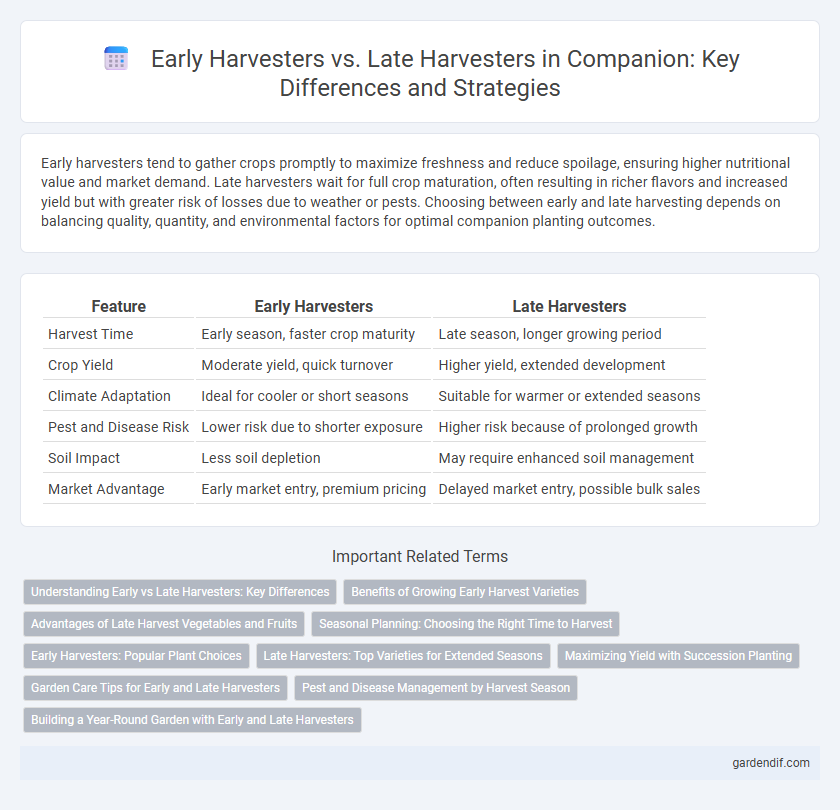
Early harvesters vs Late harvesters Illustration
Early harvesters tend to gather crops promptly to maximize freshness and reduce spoilage, ensuring higher nutritional value and market demand. Late harvesters wait for full crop maturation, often resulting in richer flavors and increased yield but with greater risk of losses due to weather or pests. Choosing between early and late harvesting depends on balancing quality, quantity, and environmental factors for optimal companion planting outcomes.
Table of Comparison
| Feature | Early Harvesters | Late Harvesters |
|---|---|---|
| Harvest Time | Early season, faster crop maturity | Late season, longer growing period |
| Crop Yield | Moderate yield, quick turnover | Higher yield, extended development |
| Climate Adaptation | Ideal for cooler or short seasons | Suitable for warmer or extended seasons |
| Pest and Disease Risk | Lower risk due to shorter exposure | Higher risk because of prolonged growth |
| Soil Impact | Less soil depletion | May require enhanced soil management |
| Market Advantage | Early market entry, premium pricing | Delayed market entry, possible bulk sales |
Understanding Early vs Late Harvesters: Key Differences
Early harvesters gather crops soon after peak maturity, prioritizing freshness and rapid market entry, which can maximize initial profits but may sacrifice yield volume. Late harvesters wait for full ripeness, enhancing sugar content and flavor complexity, ideal for premium quality products but risking weather damage and crop loss. Understanding these timing strategies helps optimize agricultural output by balancing quality, quantity, and market demands.
Benefits of Growing Early Harvest Varieties
Early harvest varieties offer the advantage of quicker crop turnover, enabling farmers to maximize land use and increase overall productivity within a single growing season. These varieties often avoid peak pest and disease periods, reducing the need for pesticides and lowering production costs. Early harvesters also provide earlier market access, allowing growers to capitalize on higher prices and meet consumer demand ahead of competitors.
Advantages of Late Harvest Vegetables and Fruits
Late harvest vegetables and fruits offer enhanced sweetness and richer flavor profiles due to extended ripening periods that allow natural sugars to accumulate. They also exhibit improved nutrient density, including higher levels of antioxidants, vitamins, and minerals beneficial for health. The increased shelf life of late harvest crops reduces post-harvest losses and supports prolonged storage and consumption.
Seasonal Planning: Choosing the Right Time to Harvest
Early harvesters maximize yield by picking crops at peak freshness, ensuring optimal nutritional value and market demand. Late harvesters benefit from extended growing periods, allowing fuller ripening, enhanced flavor development, and higher sugar content in fruits. Effective seasonal planning involves balancing these timing strategies with crop type, weather patterns, and storage capabilities to optimize overall harvest quality and profitability.
Early Harvesters: Popular Plant Choices
Early harvesters are prized for their quick maturity and ability to provide fresh produce sooner in the growing season, making them ideal for gardeners eager to enjoy homegrown fruits and vegetables rapidly. Popular plant choices among early harvesters include radishes, lettuce, spinach, and peas, which typically mature within 30 to 60 days. These crops thrive in cooler soil temperatures, enabling early planting and successive harvesting before the heat of summer slows growth.
Late Harvesters: Top Varieties for Extended Seasons
Late harvesters thrive in extended growing seasons, yielding fruit with enhanced sugar concentration and complex flavors. Varieties such as Concord, Niagara, and Marquette excel in cooler climates, ensuring robust ripening well into late autumn. Selecting these adaptable grapes supports prolonged harvesting periods, maximizing vineyard productivity and wine quality.
Maximizing Yield with Succession Planting
Early harvesters provide quick crop turnover, allowing for multiple planting cycles within a season, which maximizes overall yield. Late harvesters extend the growing period, optimizing space by filling gaps after early crops are removed, ensuring continuous production. Succession planting effectively combines these strategies to maintain soil fertility and increase cumulative harvests throughout the growing season.
Garden Care Tips for Early and Late Harvesters
Early harvesters benefit from frequent, light watering and daily monitoring to prevent pests and ensure tender produce, while late harvesters require deeper watering sessions to promote strong root development and resilience. Applying mulch around plants helps regulate soil temperature and moisture, crucial for both early and late varieties to thrive. Regular pruning encourages airflow and reduces disease risk, optimizing yield regardless of harvest timing.
Pest and Disease Management by Harvest Season
Early harvesters often face fewer pest infestations and reduced disease pressure due to shorter exposure to favorable breeding conditions for pests and pathogens. Late harvesters encounter increased risks as extended crop maturation periods create ideal environments for pests and diseases to thrive. Implementing seasonal pest and disease management tailored to harvest timing optimizes crop health and yield.
Building a Year-Round Garden with Early and Late Harvesters
Incorporating both early harvesters like radishes and lettuce with late harvesters such as pumpkins and kale ensures continuous garden productivity throughout the year. Early crops provide quick yields for immediate use while late-season vegetables extend the harvest into colder months, maximizing garden space and resources. Strategic planting schedules aligned with local climate data optimize growth cycles for a sustainable year-round garden.
Early harvesters vs Late harvesters Infographic

 gardendif.com
gardendif.com